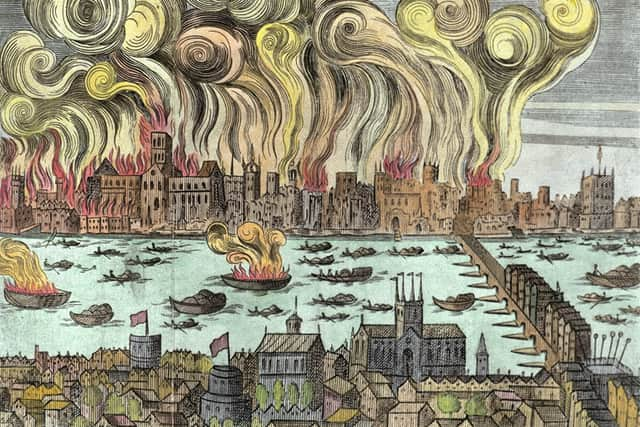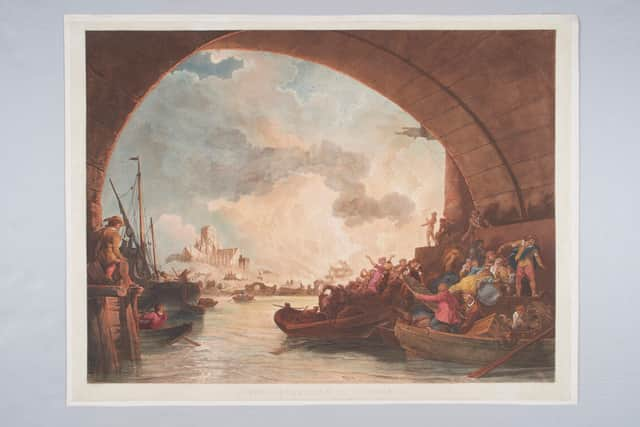Great Fire of London: First witness identified- when was the fire and what was the cause?
and live on Freeview channel 276
The person who is thought to have first raised the alarm about a blaze at a bakery that became the Great Fire of London has been identified.
The fire started in Thomas Farriner’s property in Pudding Lane near London Bridge, lasted for four days and destroyed much of the capital.
Advertisement
Hide AdAdvertisement
Hide AdThe Museum of London has announced new research which identifies the first witness as Thomas Dagger, Farriner’s apprentice.
The research undertaken for the museum’s new site in Smithfield (opening in 2026), was conducted by Professor Kate Loveman at the University of Leicester, who used letters, pamphlets and legal and guild records to discover Dagger’s identity.
Farriner’s home was the first of 13,200 houses destroyed in the Great Fire, 357 years ago.


When was the Great Fire of London?
The Great Fire of London broke out in the early hours of September 2 1666 and lasted for four days.
What was the cause?
Advertisement
Hide AdAdvertisement
Hide AdFires were quite a common occurrence in 17th century London and were soon quelled.
However the summer of 1666 had been very hot and there had been no rain for weeks, so consequently the wooden houses and buildings were tinder dry.
Starting in the early hours of the morning when there was a strong wind, the bakery blaze quickly spread between tightly-packed houses, which had been built from wood and thatch.
The fire soon took hold: 300 houses quickly collapsed and the strong east wind spread the flames further, jumping from house to house.
Advertisement
Hide AdAdvertisement
Hide AdThe fire swept through the warren of streets lined with houses, the upper stories of which almost touched across the narrow winding lanes.
Efforts to bring the fire under control by using buckets quickly failed. Panic began to spread through the city.
As the fire raged on, people tried to leave the city and poured down to the River Thames in an attempt to escape by boat.


By September 4 half of London was in flames. The King himself joined the fire fighters, passing buckets of water to them in an attempt to quell the flames, but the fire raged on.
Advertisement
Hide AdAdvertisement
Hide AdBy the time it was extinguished, an area about a mile-and-a-half (2.4km) wide along the River Thames was devastated, with 13,200 houses, 87 churches and the old St Paul’s Cathedral destroyed.
The huge fire left some 100,000 people homeless but led to widespread changes in the city, many of which still have an impact today.
Who was Thomas Dagger?
Thomas Dagger was a journeyman baker who was apprenticed to Thomas Farriner.
Dagger, aged around 24 at the time of the fire, has been identified for the first time as the servant, according to accounts.
Advertisement
Hide AdAdvertisement
Hide AdA letter from the MP Sir Edward Harley offers the most detailed account. He wrote that Thomas Farriner’s ‘man’ was woken after 1am ‘with the choke of the smoke’.
Farriner, his daughter and his man then escaped out of an upper window, but his maid died. Other sources make no mention of the unnamed man or maid, but refer to Farriner’s son being present.
The information gained from the records provides the surviving members of the Farriner household. They were Farriner, his adult children Hanna and Thomas, and his ‘man’, who can now be identified for the first time as Thomas Dagger.
It was Dagger who reportedly “discovered” the Great Fire and raised the alarm.
Advertisement
Hide AdAdvertisement
Hide AdIt is believed that Dagger had arrived in London from the village of Norton in Wiltshire after his father died and became a baker’s apprentice at 15.
At the time of the fire, he was two years out of his apprenticeship and had stayed on working for Farriner as journeyman.
Soon after the fire, Dagger striked out independently, taking his freedom in 1667, and by January 1668 had a wife, Joanna, and a baby, Frances.
He established a bakery in the parish of St Mary at Hill, Billingsgate, and started taking on his own apprentices.
Museum of London
Advertisement
Hide AdAdvertisement
Hide AdThe research was carried out for the Museum of London as part of a reimagined Great Fire display, which will go on show when the venue’s new Smithfield site opens in 2026.
Meriel Jeater, lead curator for the displays, said the discovery would "feed into the exciting new ways in which we’ll be telling the story of the Great Fire of London".
Comment Guidelines
National World encourages reader discussion on our stories. User feedback, insights and back-and-forth exchanges add a rich layer of context to reporting. Please review our Community Guidelines before commenting.
